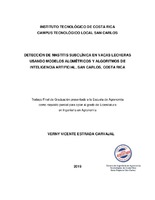Detección de mastitis subclínica en vacas lecheras usando modelos alométricos y algoritmos de inteligencia artificial, San Carlos, Costa Rica
Abstract
A mastitis detection trial was performed at Ganadera La Uno S.A, in la Marina de San Carlos (CRTM05 coordinates 458742.53 E y 1147645.93 N). The aim of this investigation was to develop and compare mastitis detection models based on alometric models and artificial intelligence algorithms. Data was colected from an automated milking system equipped with online measuarements. Diseased cows were defined either as those which recorded somatic cell count (CCS) greater than 200 000 cs/ml or a those with a somatic cell count score (SCCS) of four or greater. The best response variable in was SCCS due to its compliance with the normal distribution and adequate fit in the models. Electric conductivity (CE), milk yield (PL), days in milk (DEL), age (ED), reproductive condition (ER) and lactation number (NP) were used as predictive variables of SCCS. Alometric models were linear or linearized and showed R2 values lower than 0.32. Moreover, predictive value of these models was inadequate in terms of sensibility (SEN) and specificity (ESP), since the specificity was 55% when the sensitivity was fixed at 80% and the area under the ROC curve of these models approached 75%. Results do not support the use of a Naïve Bayes classification algorithm to predict mastitis because sensitivity and specificity values were inadequate. The best predictive model was a linear regression model combined with machine learning, with values of ESP and ROC area curve of 84.3 and 92.1% respectively (80% fixed sensibility). This work presents evidence of the potential value of artificial intelligence models in mastitis detection in dairy farms.
Description
Tesis (Licenciatura en Ingeniería en Agronomía). Instituto Tecnológico de Costa Rica. Escuela de Agronomía, 2019.


